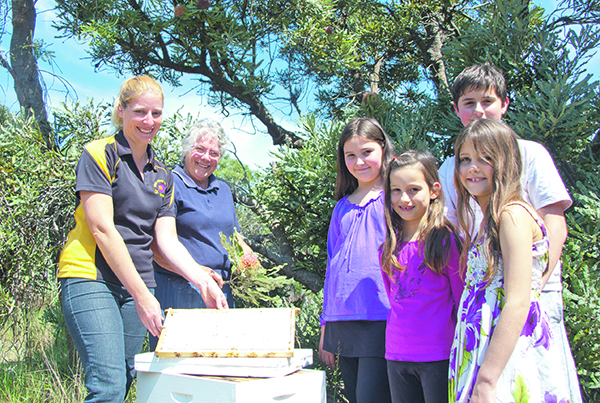By Tamieka Preston
As visitors to West Coast Honey enter the sweetly-fragrant premises on Gingin Brook Road they are transported into the fascinatingly intricate world of the honeybee, an insect who holds a third of the world’s food production at the mercy of it’s tiny pollen-laden hands.
Participants in the ‘Honeybee Experience’ held as part of the Gingin Science Festival during
September were treated to an extended tour of the honey headquarters hosted by the queenbee of the Fewster family Kerry Fewster. Kerry joined one of WA’s oldest bee-keeping clans when she married second generation apiarist John Fewster back in 1966, and whilst she attributes all the natural instinct and field experience of
bee-keeping to her husband, Kerry’s knowledge of the business of bees is gargantuan.
A glass encased hive in the centre of the shop draws in the visitors like, well, bees to honey, and a young girl is the first to spot the queen – who is being lavishly preened by her cohort. It’s hard not to envy the bee monarch who reigns supreme over her realm living up to 8 years in comparison to the short, six-week life of her worker bee progeny.
Kerry explains to the captivated group the unique structure of honeybee society, “Each bee inside the hive has a role: a guard bee, nurse bee, worker bee, attendant… They all work together in harmony.” Apparently bees are the most skilled mime-artists of the animal kingdom as well as being enviably organised.
It’s clear we have much to learn from this marvellous mini-beast, and as the primary pollinators of many agricultural crops – as well as most fruit and vegetable flowers – their survival is synonymous with our own.
For the Fewsters, bees are their livelihood. As the second-largest honey producer in the state, the current threat to bee survival is a primary concern. So what’s bugging the bees?
“At the moment we are the only continent in the world without Varroa mite,” says Kerry. This deadly mite has wiped out hives all over the world, and Australian apiarists are fearful it will soon reach our shores. Our biggest
problem in WA is American foulbrood – and it’s spread by feral bees. Destruction of the native environment and use of pesticides is also a major threat to our bees. “John can tell by the smell of the hive if there’s disease and just by lifting the lid of the hive he knows if the queen it
failing,” explains Kerry.
Even in our precious, virtually disease and pest-free environment there’s been a decline in beekeeping generally – and it’s affected honey sales domestically and in export.
“I don’t know what’s going to happen in the future. The continuation of the beekeeping
industry in Australia is a concern.” says Kerry, “There are a lot of aged beekeepers and it can
take 10-20 years to properly learn and gain the knowledge of beekeeping, the environment,
honey producing flora and the seasons.” Michael Bellman, WA Supply Manager of
Capilano, who prepares the Fewsters honey for market, is actively seeking potential beekeepers.
“I simply cannot source enough honey to satisfy demand,” he laments, “I am turning
away overseas customers on a regular basis.”
Unfortunately beekeeping hasn’t been a popular choice for young people.
Kerry, however, is hopeful about the next generation. A grandson who is showing interest would make a fifth generation beekeeper in the family. Meanwhile, she is educating the public at the West Coast Honey shop – and they are loving it. Whilst Kerry has most of the answers the group poses, some things, she declares, “Are
between bees and nature”, and the mystery is more wonderous than a definative answer.
At the conclusion of the tour, honey tastings are on offer, and everyone wants to know Kerry’s favourite. “I used to be a Whitegum girl,” she confesses, “I did. I loved it – it tastes like caramel and when it crystalizes you can cut little pieces off and eat like a lolly! But now I’ve moved to Jarrah – it’s not so sweet.”
West Coast Honey is open from Wednesday to Sunday from 10am to 4pm (and every day over the Sept/Oct School holidays), and it’s one of the only places you can buy the different floral varieties and taste for yourself the difference between Whitegum and Jarrah – I’ll bet you can’t resist buying both!








